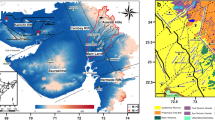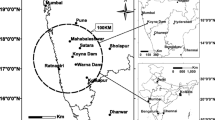Abstract
A first order seismic microzonation map of Delhi is prepared using five thematic layers viz., Peak Ground Acceleration (PGA) contour, different soil types at 6 m depth, geology, groundwater fluctuation and bedrock depth, integrated on GIS platform. The integration is performed following a pair-wise comparison of Analytical Hierarchy Process (AHP), wherein each thematic map is assigned weight in the 5-1 scale: depending on its contribution towards the seismic hazard. Following the AHP, the weightage assigned to each theme are: PGA (0.333), soil (0.266), geology (0.20), groundwater (0.133) and bedrock depth (0.066). The thematic vector layers are overlaid and integrated using GIS. On the microzonation theme, the Delhi region has been classified into four broad zones of vulnerability to the seismic hazard. They are very high (> 52%), high (38–52%), moderate (23–38%) and less ( < 23%) zones of seismic hazard. The “very high” seismic hazard zone is observed where the maximum PGA varies from 140 to 210 gal for a finite source model of Mw 8.5 in the central seismic gap. A site amplification study from local and regional earthquakes for Delhi region using Delhi Telemetry Network data shows a steeper site response gradient in the eastern side of the Yamuna fluvial deposits at 1.5 Hz. The ‘high’ seismic hazard zone occupies most of the study area where the PGA value ranges from 90 to 140 gal. The ‘moderate’ seismic hazard zone occurs on either side of the Delhi ridge with PGA value varying from 60 to 90 gal. The ‘less’ seismic hazard zone occurs in small patches distributed along the study area with the PGA value less than 60 gal. Site response studies, PGA distribution and destruction pattern of the Chamoli earthquake greatly corroborate the seismic hazard zones estimated through microzonation on GIS platform and also establishes the methodology incorporated in this study.
Similar content being viewed by others
References
Avouac J. and Tapponnier P. (1993). Kinematic model of active deformation in central Asia. Geophys. Res. Lett. 20: 895–898
Bilham R. and Gaur V. K. (2000). The geodetic contribution to Indian seismotectonics. Current Sci. 79: 1259–1269
Bilham R., Blume F., Bendick R. and Gaur V. K. (1998). The geodetic constraints on the translation and deformation of India: Implications for future great Himalayan earthquakes. Current Sci. 74: 213–229
Bilham R., Gaur V. K. and Molnar P. (2001). Himalayan seismic hazard. Science 293: 1442–1444
Bilham R. (1995). Location and magnitude of the Nepal earthquake and its relation to the rupture zones of the contiguous great Himalayan earthquakes. Current Sci. 69: 101–128
BIS: 2002, IS 1893–2002 (Part 1): Indian Standard Criteria for Earthquake Resistant Design of Structures, Part 1 – General Provisions and Buildings, Bureau of Indian Standards, New Delhi
Chandra U. (1992). Seismotectonics of the Himalaya. Current Sci. 62: 40–71
Chauhan P. K. S., Mohanty W. K. and Roonwal G. S. (1998). Earthquake Hazards in area of low seismicity: An example from NE. Available in Delphi region. The Indian Precambrian. Sci. Publ., Jodhpur, 523–530
DeMets C., Gordon. R. G., Argus D. F. and Stein S. (1994). Effect of recent version to the geomagnetism reversal time scale on estimates of current plate motions. Geophys. Res. Lett. 21: 2191–2194
Gahalaut V. K. and Chander R. (1997). On interseismic elevation change and strain accumulation for great thrust earthquakes in the Nepal Himalaya. Geophys. Res. Lett. 24: 1101–1014
Gansser A. (1964). Geology of the Himalayas. Interscience, New York, 289
GSI Report: 2000, A Geoseismological report on Chamoli earthquake of March 29, 1999
Jain, S. K., Murty, C. V. R., Arlekar, J., Rajendran, C. P., Rajendran, K., and Sinha, R.: 1999, Special Report, Earthquake Engineering Research Institute (EERI), California 33, 1–8
Kamble, V. P. and Chaudhury, H. M.: 1979, Recent seismic activity in Delhi and neighborhood. Mausam 30, 2&3, 305–312
Khattri K. N. (1999). An evaluation of the earthquake hazard and risk in northern India. Himalayan Geol. 20: 1–46
Kumar, S., Chandra, P., Srivastava, S. S., Kar, S. K., Sharma, V. K., Sanwal, R. K., Ram, S., Dungrakoti, B. D., Khan, E. A., and Baranwal, M.: 1997, Contributions of Geological Survey of India in Delhi Area – A Resume, 1–37
Lyon-Caen H. and Molnar P. (1985). Gravity anomalies, flexure of the Indian plate and structure, support, and evolution of the Himalaya and Ganga basin. Tectonics 4: 513–538
Mohanty, W. K. 1997, Seismicity and related studies of Delhi and the adjoining region, Unpublished. PhD Thesis, Delhi University, India, 139
Molnar, P. and Chen, W. P.: 1982, Seismicity and mountain building. In: K. Hsu (ed.), Mountain Building Processes. Academic, New York, pp. 41–57
Nath S. K., Sengupta P., Srivastav S. K., Bhattacharya S. N., Dattatrayam R. S., Prakash R. and Gupta H. V. (2003). Estimation of S-wave site response and around Delhi region from weak motion data, Proc. Indian Acad. Sci. (Earth and Planet. Sci.), 112, No. 3, Sept. 2003, 441–462
Nath S. K. (2004). Seismic hazard mapping in the Sikkim Himalaya through GIS integration of site effects and strong ground motion attributes. Nat. Hazards 31(2): 319–342
Rajendran C. P. and Rajendran K. (2005). The status of central seismic gap: A perspective based on the spatial and temporal aspects of the large Himalayan earthquakes. Tectonophysics 395: 19–39
Rajendran K., Rajendran C. P., Jain S. K., Murty C. V. R. and Arlekar J. N. (2000). The Chamoli earthquake, Garhwal Himalaya: Field observations and implications for seismic hazard. Current Sci. 78(1): 45–51
Seeber, L. and Armbruster, J. G.: 1981, Great detachment earthquakes along the Himalayan arc and long-term forecasting, in Earthquake Prediction: An International Review, Maurice Ewing Series 4. American Geophysical Union, Washington DC, 259–277
Singh S. K., Mohanty W. K., Bansal B. K. and Roonwal G. S. (2002). Ground motion in Delhi from future large/great earthquakes in the central seismic gap of the Himalayan arc. Bull. Seismological Soc America 92(2): 555–569
Verma R. K., Roonwal G. S., Kamble V. P., Mohanty W. K., Dutta U., Gupta Y., Chatterjee D., Kumar N. and Chauhan P. K. S. (1995). Seismicity of Delhi and its surrounding region. J. Himalayan Geology 6(1): 75–82
Author information
Authors and Affiliations
Corresponding author
Rights and permissions
About this article
Cite this article
Mohanty, W.K., Walling, M.Y., Nath, S.K. et al. First Order Seismic Microzonation of Delhi, India Using Geographic Information System (GIS). Nat Hazards 40, 245–260 (2007). https://doi.org/10.1007/s11069-006-0011-0
Received:
Accepted:
Published:
Issue Date:
DOI: https://doi.org/10.1007/s11069-006-0011-0




